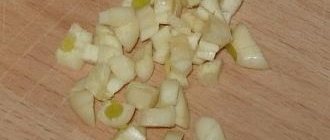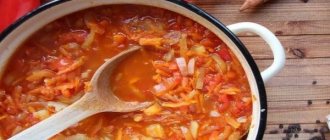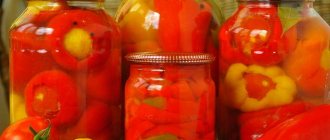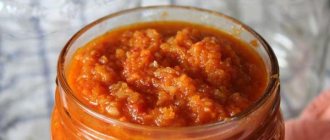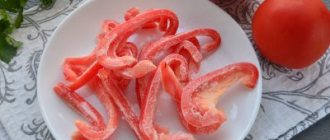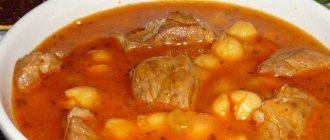What dishes are they added to?
Pickled pepper perfectly complements first courses: borscht, solyanka, pea soup, rassolnik, fish soup.
The vegetable is used as an appetizer at a casual dinner or a formal table. The preparations are taken with them into nature. Pepper goes well with baked potatoes, dill, barbecue or camp soup. Stuffed peppers are great for a picnic—they don’t need to be heated, and they take up minimal space.
Fans of spicy dishes prefer to eat pepper with black toasted bread. This simple combination has a bright and unusual taste.
Pickled peppers for the winter - recipe with photos
Wash the ripe sweet peppers and dry them. Please ensure that no dirt remains near the stalks.
Wash the greens and let them dry. We take our favorite herbs. Delicious with parsley and dill, but you can add cilantro and basil. The result is a marinade with an Italian accent.
Chop the washed greens with a knife.
Pierce the peppers through with a fork in several places. This is necessary for them to release the air. After all, we will ferment them entirely.
If you don’t want to get whole pickled paprika, you can cut the peppers into pieces. The choice is up to the hostess.
Place chopped peppers in a saucepan, add chopped garlic, chopped herbs, and favorite spices. The bouquet can be anything depending on your preferences and the assortment of the basket with spices.
Preparing the filling. Pour coarse salt (1.5 tsp) into a glass of cold water.
Stir and pour into peppers.
We press them down with our hand and place pressure on top, removing the palm. In this position, we send the bowl of paprika to a secluded place at room temperature for two to four days.
Then we place the finished peppers in clean jars and fill them with boiled brine. We prepare the solution as follows: in a glass of running water, add all the strained marinade remaining in the bowl where the peppers were fermented, and 1.5 teaspoons of salt. Bring the liquid to a boil and pour it over the peppers in the jars.
Cover the pickled bell peppers with boiled screw caps or plastic ones.
Store in the refrigerator. This unusual dish of fresh vegetables will appeal to lovers of simple dishes. I took out the pepper, cooked the pasta - and dinner was ready for the bachelor. And those who are happy in their family can decorate the festive table with paprika or diversify the everyday one. Already read: 8807 times
One of the oldest ways of preparing vegetables, fruits and mushrooms for future use is fermentation. Natural lactic acid is a natural preservative, which contributes to the long-term storage of products and their excellent taste. How to ferment eggplants, garlic or peppers correctly
watch and read further.
Little tricks for making delicious pickled peppers
Experienced housewives know the tricks of preserving spicy vegetables. To make the preparation piquant, pay attention to the following nuances:
- peppers for long-term storage are rolled into wide-necked jars;
- whole pods are pierced so that the air comes out of them and is replaced by brine during fermentation;
- It is better to take late varieties of cabbage for stuffing - it is more juicy and sugary, which speeds up the process of natural fermentation;
- coarse rock salt is used for preparations;
- For stuffing, slightly unripe fruits with thick, fleshy walls are chosen.
Recipe for hot pickled peppers in Armenian Tsitsak
- Do not wash the pods of picked green or red hot peppers immediately, but leave them on the kitchen table for 2 days. The pepper should become slightly wrinkled and softer, since you need to work with fresh, but slightly wilted pepper. After the pepper has shriveled, we wash it and pierce it through with a fork in 2 places.
- Peel the garlic and rinse. Rinse the dill, drain in a colander, allow excess moisture to drain, and chop coarsely with a knife. Take a large saucepan or other dish and pour garlic, pepper and herbs into it. Mix all ingredients well with your hands.
- Dissolve in ordinary, not boiled, but preferably well or spring water the amount of salt indicated in the recipe. Pour the prepared brine into the pan with mixed garlic, pepper and herbs. Cover the food with a lid of a smaller diameter and place the food under pressure. All products must be covered with brine.
- In this state, covering the pan with gauze to prevent insects, we leave the pepper to ferment for several days. The pan should remain in a bright room, out of direct sunlight, and at room temperature. The finished peppers will no longer have a pronounced green or red color, but will acquire a yellow tint. The warmer it is, the faster they will turn yellow. Typically this procedure takes from 3 to 10 days.
- Now let's start rolling our hot peppers into jars. It is not necessary to sterilize the jars, but you need to rinse them with hot water and soda. We take all the peppers with herbs and garlic out of the pan and put them in a colander. Let all the liquid drain properly. Even though the brine turned out to be aromatic, it’s not worth tasting, so we throw it away.
- We begin to place the peppers with herbs and garlic into jars, while once again squeezing out the liquid. The mass fits into the jars very tightly, compact it with your hands, don’t be lazy. Please note that after the jars have been filled and settled slightly, more brine appears at the bottom; be sure to drain it.
- Place the pepper without brine in a pan of water and sterilize it for 10 minutes after the water boils. Roll into jars. If you have never done this, then fill the peppers in jars with new brine, but not cold, but boiled and hot. Sterilize for 10 minutes and roll into jars. We recommend storing peppers in a cool and dark place. And the longer he insists, the “angrier” he will be.
- Armenian pickled hot pepper Tsitsak
is served as a very spicy snack on its own or together with other pickles in one cup.
It has a very long shelf life. Most often, Tsitsak is served with fried, stewed or boiled meat dishes. Not bad for boiled potatoes. For lovers of spicy dishes, Armenian Tsitsak
is a real outlet.
Enjoy your meal!
Preface
Hot peppers are beloved by fans of dishes with light notes of heat or fiery piquancy. In order not to deprive yourself of the pleasure of enjoying this amazing vegetable in any season of the year, we suggest preparing hot peppers for the winter; many housewives have already appreciated the recipes for its preparation. Tips for preparing chili will be especially useful for those who want to please the stronger half of humanity, because most men will really like such preservation.
Pickled hot pepper
Ingredients:
- hot pepper – 1 kg;
- celery root – 10 g;
- horseradish root – 8 g;
- parsley – 15 g;
- cherry leaf – 5 g;
- vinegar – 60 ml;
- table salt (non-iodized) – 60 g;
- water – 1 l.
Preparation:
- The water is boiled, after boiling, salt and vinegar are added, brought to a boil again and filtered through cheesecloth.
- The peppers are washed with running water and pierced at the base.
- Celery and horseradish roots are peeled and cut into large pieces.
- Place the prepared peppers in a deep bowl, add horseradish, celery, parsley and cherry leaf in layers.
- The workpiece is filled with cooled brine and placed under a press in a warm place.
- After 10-12 days, the appetizer is transferred to the cold, adding cold brine as it evaporates.
Pickled pepper recipe with photo
- Green bell pepper – 2 kg;
- white cabbage of winter varieties – 1.5 kg;
- carrots – 300-350 g;
- onions – 4 pcs;
- Refined sunflower oil – 3-4 tbsp. l;
- coarse table salt (regular rock salt) – 4-5 tsp;
- celery – 1 bunch;
- parsley – 2 bunches;
- dill - 1 bunch.
Pickled bell pepper recipe step by step
For fermentation and stuffing with cabbage, choose small peppers, 6-8 cm high, green in color. Use a knife to trim around the stalk, remove the cap, and shake out the seeds. Wash the peppers inside and out. Boil water, drop a few peppercorns into boiling water for one minute. Remove peppers with a slotted spoon and cool under cold water. Turn over and leave to drain on a board or in a colander.
For the filling, cut the onion into small cubes.
Grate the carrots on a coarse grater (the same as for sauerkraut).
Take a stewpan or cauldron, a frying pan with high sides. Heat half the oil, add the onion, heat it, steam it in the oil. There is no need to fry the onion, you don’t even need to fry it slightly, it’s like stewing in oil over low heat.
Then add the rest of the oil and carrots. Do not fry it either; the carrots will become soft, soaked in oil, but not dry out.
Chop the cabbage finely, sprinkle with table salt (2 tsp), rub with your hands to release juice.
Finely chop all the greens you add to the vegetable filling for pickled bell peppers. Add to cabbage, stir.
Place stewed carrots and onions in the cabbage with greens and pour out all the oil in which the vegetables were stewed.
Mix everything, add salt, leave for 10-15 minutes until the salt dissolves. Try the filling; it should taste slightly salty.
Take the peppers one at a time and stuff them tightly with cabbage, vegetables and herbs. Place upright in a bowl or pan, placing them close to each other. Pour the remaining cabbage brine over the peppers and cover with sprigs of herbs on top. Place an inverted plate or saucer on the peppers and place a jar of water (0.5-0.7 liters) covered with a lid on it. Cover with a towel, place near the radiator or in the kitchen in a warm place (room temperature).
The next day or the day after, the cabbage will give juice, the pepper will ferment in brine. After three to five days, a characteristic sour smell of fermentation will appear. The pepper will change color to darker. Move the dishes with pepper to a cool balcony or take them to the basement. The peppers will finally ferment in a week (we count from the day of stuffing with cabbage). You need to store pickled peppers stuffed with cabbage in a cool place in a sealed container so that it does not over-acidify and the brine does not evaporate.
A dish that is amazing in taste is pickled bell pepper. Paprika is marinated for three days in a spicy sauce based on garlic, herbs and salt. The result is an amazing snack for connoisseurs of simple but tasty food that came from the people. Pickled peppers can be eaten with a side dish and can be used to prepare salads and multi-ingredient snacks. They remain bright, juicy and aromatic for a long time.
To prepare pickled peppers for the winter you will need:
- bell pepper – 3-6 pcs.;
- garlic – 3 cloves;
- spices – 1 tsp;
- salt – 3 tsp;
- water – 1 tbsp.;
- greens – 30 g.
Tips and recommendations from experienced housewives
To make fermented snacks tasty and not spoil for a long time, we suggest you familiarize yourself with the cooking secrets from experienced housewives:
- Use vegetables from your own garden beds or purchase them from trusted gardeners. Self-grown crops are many times tastier and healthier than store-bought products.
- Use pepper varieties intended for harvesting. For example, the variety Chocolate Handsome, Adept, Yantar, Bogdan.
- The pepper must have fleshy walls at least 4 mm thick.
- Choose vegetables of different colors: red, yellow, green. Such preparations look appetizing and attract attention.
- For the starter, purchase coarse rock salt.
- Smooth fruits, without damage or scratches, are suitable for pickling.
- Wash vegetables, herbs, dishes and cutlery thoroughly.
- When preparing dishes with cabbage, use dense and white varieties. The cabbage should be juicy and crispy.
- For brine, use clean filter water.
- Add bitter and hot peppers at your discretion. Don’t be afraid to add spices and spices to the jars: bay leaf, cloves, coriander, cumin. They give the dish an unusual taste.
- Observe shelf life.
We suggest you familiarize yourself with How to properly treat an open wound and what to apply to make it heal faster - an algorithm for treating a wound and a list of antiseptics
Quick cabbage with bell pepper for the winter
You can quickly prepare pickled cabbage with sweet peppers for the winter. The cabbage turns out juicy and fresh with a spicy taste. In this case, the salad can be eaten almost immediately, without waiting for the winter cold. You can store such a treat for a whole year in a cool, darkened room; use an open jar within 14 days.
- Cabbage – 1.5 kg
- Carrots – 0.5 kg
- Onion – 0.3 kg.
- Sweet pepper – 0.5 kg.
- Salt – 25 g
- Vinegar – 80 ml
- Granulated sugar – 20 g
- Vegetable oil – 100 ml
- Laurel – 4 leaves
- Pepper – 4 pcs.
Process for preparing pickled cabbage:
- Peel the carrots, rinse, dry and chop into strips.
- Shred the cabbage without the top leaves with a knife or on a shredder.
- Separate the pepper from the seeds and stalks. Wash the vegetable and cut into small strips.
- Dip the peeled onion in water and cut into strips.
- Mix vegetables in a separate bowl.
- Prepare the marinade by mixing vinegar with sugar and salt. Stir the mixture until the bulk ingredients are completely dissolved. Pour in vegetable oil and mix everything again.
- Pour the marinade over the vegetable mixture and knead with your hands.
- Place pepper and bay leaf into sterile jars. Fill the containers to the top with vegetable mixture. Cover the jars with lids.
- Sterilize the workpieces in a water bath for 15 minutes.
- Preserve the jars with lids, cool and store.
Quick cabbage with bell pepper
Stuffed with cabbage
An excellent recipe for the holiday table. Culinary experts advise using young cabbage with crispy leaves.
For preparation you need:
- 10 smooth peppers;
- 1/2 cabbage;
- 3 small onions;
- 20 ml vegetable oil;
- 2 carrots;
- 3 cloves of garlic;
- 1 bunch of dill;
- 1 bunch of parsley;
- 1 liter of water;
- 30 g salt;
- 3 black peppercorns.
Cooking method:
- Wash the peppers and remove the core. Blanch in boiling water for 2 minutes. Blanching is the treatment of food with boiling water or steam.
- Transfer vegetables to cold water.
- Chop the cabbage, add salt and mash with your hands.
- Finely chop the onions and fry over low heat.
- Grind the carrots on a fine grater, cut the garlic cloves into slices. Combine onions, garlic and carrots, mix thoroughly in a frying pan.
- Chop the greens into the cabbage and add the vegetables from the pan. Mix thoroughly and add salt to taste. Leave the mixture for 15 minutes.
- Stuff the peppers with cabbage as tightly as possible.
- Prepare the brine: add salt and spices to the water to taste.
- Place stuffed peppers in jars vertically. Pour in chilled brine.
- The product is ready for use after 2 weeks. Keep refrigerated.
Sauerkraut with pepper: an elusive recipe
Bad luck: there are so many recipes - and everything is wrong: sometimes you need to marinate, sometimes with brine, sometimes everything is good - but it doesn’t work. But the problem is this: cabbage and peppers are not fermented. Unexpected, but true.
However, our last recipe is precisely ripening - but not in its pure form.
Fermentation is the process of lactic acid fermentation. Pepper, for unknown reasons, or more precisely, due to its composition, is not subject to traditional ripening. It is salted and pickled, but not fermented.
It is good in a vinegar-salt marinade; it can be prepared using the salting method - in a saline solution or with salt and vinegar. But classic ripening is not for him.
But what about the luxurious salads that are at the market, in the supermarket, or at a party? And these are all marinades. They are often called salads.
Alas, these are not classic pickles. But they are also good: tasty, can be stored - often from two to three days to a week or more than a month, depending on the recipe. Some can be stored in the refrigerator all winter.
And don’t let those looking for a recipe for sauerkraut with bell pepper be disappointed: there isn’t one. As an option, add it to the finished dish a couple of hours before and let it brew, salt the pepper before serving. But - there are better recipes - the ones that everyone likes, but no one can find.
Recipe No. 1 Sauerkraut with bell peppers and carrots
A brilliantly simple and impeccably tasty recipe: quick sauerkraut with bell peppers and carrots - ready in a day.
Sauerkraut with pepper: the recipe is real. And don’t trust those who know how to ferment it in the classical sense of the word.
Sweet and sour, aromatic, crispy - but truly pickled, and very similar to pickled. Considering that fermentation in relation to the dish is a conditional name, we will prepare a quick marinade.
Ingredients per 1 liter:
- Shredded cabbage 600 g;
- Carrots 1-2 pcs. 200-250 g;
- Sweet pepper 1 pc.
- Allspice, cumin or dill seeds - to taste.
For 3 liters of marinade (brine):
- Hot water (boiled) 3 l;
- Salt 1 tbsp;
- Sugar 1 tbsp;
- Vinegar 70% essence 1 tbsp. or 7-8 tbsp. vinegar 9%.
1. Chop cabbage and carrots. 2. Cut the pepper into thin slices - as for a salad. 3. For the brine: immerse measured salt and sugar in boiling water and mix. When the boiling water has cooled slightly, pour in vinegar and cool. 4. Mix cabbage with carrots and peppers, spices, place, compacting, in a jar. Pour in brine and compact again so that the brine covers the contents. Cover with a lid and place in the refrigerator.
After 24 hours, the cabbage is ready - an incredible marinade will turn it into a fragrant, crispy delicacy in 24 hours. Serve with aromatic oil, adding sugar and onions to taste.
Recipe No. 2 Sauerkraut with bell pepper for the winter
It will win the hearts of those who do not respect sauerkraut, and will break the hearts of those who crave only classic recipes. Although this is a classic, and an extremely balanced combination of sugar, salt and vinegar in an oily marinade.
Recipe for sauerkraut with pepper: simply delicious.
Prepares quickly: ready in 3-5 days, depending on the variety and fineness of the cut.
Ingredients for 3.5-4 l:
- Shredded cabbage 2.5-3 kg;
- Carrots 2-3 pcs. neat size;
- Sweet red pepper 3-5 pcs. (to taste or 1-2 pieces per 1 kg of cabbage);
- Onions 2-3 pcs.
- Cilantro seeds or dill.
For the marinade:
- Vegetable oil 200 ml;
- Vinegar 9% 70-100 g (to taste) or 1.5 tbsp. per 1 kg of finished product;
- Salt 40-50 g (3 tbsp flush with the edge, without a slide) or 15 g per 1 kg of sauerkraut;
- Sugar 1/2 cup (4-5 tbsp) or 1.5-2 tbsp. per 1 kg.
1. Chop the cabbage, grate the carrots, cut the pepper into graceful half rings - more precisely, divide the half rings into 2-3 parts.
Advice! When preparing for long-term storage, the amount of carrots should be reduced: they make the sauerkraut with pepper soft and yellow. The classic combination is 80-100 g of grated carrots per 1 kg of finished product.
2. Mix the chopped vegetables, grind with a pinch of salt and sugar to release the juice slightly.
